
Andy Lloyd's Dark Star Blog

Blog 72 (March 2019)
Super-Earth Planet Nine Just Got Closer
When detectives are looking for a suspect, they often produce an identikit image of the alleged villain. For the last few years, astrophysicists searching for the elusive Planet Nine object have produced the astronomical equivalent of an identikit. Back in 2016, when Caltech scientists Michael E. Brown and Konstantin Batygin published their theoretical work about the proposed existence of this planet (1), their calculations led them to believe that Planet Nine (a re-branding of Planet X) was somewhere north of 600AU away, and might be a mini-Neptune like object. At about ten Earth masses, this object might be the incomplete core of an ejected ice giant, or a massive rocky super-Earth.
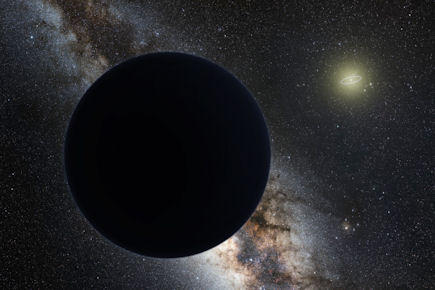
Credit: ESO
Now, three years later - and with more data to play with from the extended scattered disk beyond the Kuiper belt - the Caltech professors, teaming up with scientists from the University of Michigan, have made a significant adjustment to this Planet Nine Identikit. Their new work on the Planet Nine hypothesis will be published next month in Physics Reports (2). Konstantin Batygin summarised the new properties for the missing Planet Nine in a series of tweets:
"First, an exec summary of the paper: we did thousands of new P9 simulations, and realized that P9 is smaller (m~5Mearth), closer (a~400-500AU), more circular (e~0.2) and visually brighter (V~23) than we originally thought" (3)
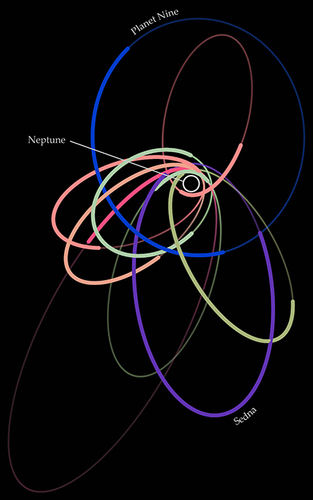
Image Credit: Mike Brown
Mike Brown recently went for a Planet X object at 400 AU that is 6 times the mass of the Earth:
"In a sophisticated comparison of solar-system observations to numerical simulations, we find a best match to be a putative Planet Nine that is approximately six times the mass of Earth, inclined with respect to the ecliptic by a little less than 20 degrees, and in a moderately eccentric orbit about 400 times as distant from the Sun as Earth." (4)
This is a slight variation on the numbers indicated in the new paper's abstract, particularly regarding the planet's range of distance and eccentricity:
"This newly outlined dynamical architecture of the distant solar system points to the existence of a new planet with mass of m ∼ 5 − 10 M⊕, residing on a moderately inclined orbit (i ~15− 25 deg) with semi-major axis a ~ 400 − 800 AU and eccentricity between e ~ 0.2 − 0.5" (2)
The 'Physics Reports' paper itself provides a broad and detailed review of the history of Planet X, not dissimilar in scope to my own recently published book 'Darker Stars' (5). The astrophysics paper also presents the dynamical modelling that has led to the Planet Nine hypothesis, considerably updated from the previous work from 2016. The object is smaller, nearer and, possibly, brighter than previously thought. Planet Nine now more closely fits the preceding ideas presented by Trujillo and Sheppard about Planet X in 2014 (6).
This object is now thought to be much more like a super-Earth than a mini-Neptune, rather closer, dare I say, to the mythical 'Nibiru' object described by the late Zecharia Sitchin (7). The main difference lies in the planet's orbital properties: Planet Nine's orbital period is much greater than 'Nibiru', whose eccentric orbit is believed to bring it into the planetary zone of the solar system at perihelion. No such excitement associated with Planet Nine, whose orbital path remains well clear of any other planet.
Yet, undeniably, the two are edging closer together.
"At five Earth masses, Planet Nine is likely to be very reminiscent of a typical extrasolar super-Earth," says Batygin, an assistant professor of planetary science and Van Nuys Page Scholar. Super-Earths are planets with a mass greater than Earth's, but substantially less than that of a gas giant. "It is the solar system's missing link of planet formation. Over the last decade, surveys of extrasolar planets have revealed that similar-sized planets are very common around other sun-like stars. Planet Nine is going to be the closest thing we will find to a window into the properties of a typical planet of our galaxy." (8)
Planet Nine continues to evade detection, after three years of searching, and a 99.8% probability that the clustering effect is a real phenomenon rather than being mere coincidence, or related to observational bias (9). Is this because there are properties associated with planetary objects lying in interstellar space (like Planet Nine does) that are different to those cocooned within the Sun's heliosphere? I believe so. The debate needs to open up as to why planets located beyond the heliosphere, whose presence is indicated by their effect upon other known objects, remain so elusive, both in visible light and infrared. Basic assumptions need to be questioned about the local environments around interstellar planets.
Just as a side note, the record for the most distntt object spotted within the solar system has been broken again this month. At between 130 and 150 AU, Scott Sheppard and Chad Trujillo's new 'FarFarOut' object breaks new ground (10). But where is it along its orbit? Perihelion? Aphelion? Somewhere in between? This has yet to be determined, and thus what it might tell us about Planet X. FarFarOut could be an extended scattered disk object lying further out along its orbit than the others which have been identified to date, or an inner Oort cloud comet-like object that is nearer perihelion. Or something in between.
Written by Andy Lloyd,
1st - 7th March 2019
References:
1) Michael E. Brown & Konstantin Batygin "Orbital Clustering in the Distant Solar System", The Astronomical Journal, 2019; 157 (2): 62
2) Konstantin Batygin, Fred C. Adams, Michael E. Brown and Juliette C. Becker "The Planet Nine Hypothesis" Physics Reports 2019,
3) @kbatygin 27 February 2019
4) Mike Brown "The Planet Nine hypothesis" 1 March 2019, Physics Today 72, 3, 70,
physicstoday.scitation.org doi
5) Andy Lloyd "Darker Stars" Timeless Voyager Press, 2019
6) Chad Trujillo & Scott Sheppard "A Sedna-like body with a perihelion of 80 astronomical units", Nature, 507: 471-474, 27th March 2014,
7) Zecharia Sitchin "The Twelfth Planet" Avon 1976
8) Science Daily "New arguments in favor of a ninth planet in our solar system" 27 February 2019
9) Michael Brown and Konstantin Batygin "Orbital Clustering in the Distant Solar System", The Astronomical Journal, 157(2)
10) Nola Taylor Redd "New "FarFarOut" World Is the Most Distant Solar System Object Known" 7 March 2019
www.scientificamerican.com article
'Dark Star' Exoplanet in Planet Nine-style Orbit
One of the theoretical objections to a Planet X body may have been overcome through some recent detective work elsewhere. A giant exoplanet known as HD 106906b orbits a young binary system 300 light years away, which also features an unusual asymmetric dust disk. The system is estimated to be about 15 million years old, and this young exoplanet, which is of sub-brown dwarf proportions, has been directly imaged by the fires of its own young light. HD 106906b has a much wider separation from its parent star than generally considered possible for formation from within the binary's protoplanetary disk. In other words, it shouldn't be located as far from the binary as it is.
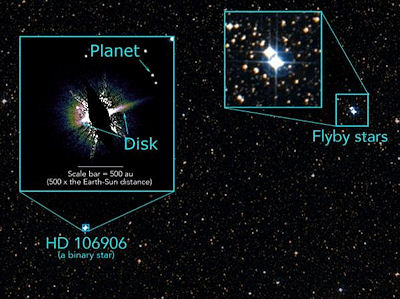
Image Credit: Paul Kalas, UC Berkeley
"HD 106906 ... was found to have a massive planet in a highly unusual orbit. The planet, dubbed HD 106906 b, has a mass of about 11 Jupiters, and it orbits HD 106906 -- recently revealed to be a binary star -- in an orbit tipped about 21 degrees from the plane of the disk that contains all the other material around the star. Its current location is at least 738 times farther from its star than Earth is from the sun, or about 18 times farther from its star than Pluto is from the sun." (
1)The distance and inclination of this massive exoplanet is similar to Planet Nine, although the size of this object is much larger - of 'Dark Star' proportions.
It is thought that the exoplanet must have been affected by a passing star. Astronomers Robert de Rosa and Paul Kalas think that the planet's stable positioning so far from the parent binary was facilitated by the passage of a passing star 2-3 million years ago (2). This might explain the not uncommon observation of misplaced planets orbiting young stars exhibiting otherwise settled protoplanetary disks:"One of the mysteries arising from the study of exoplanets is that we see systems where the planets are misaligned, even though they are born in a flat, circular disk," said Paul Kalas, a UC Berkeley adjunct professor of astronomy. "Maybe a cosmic tsunami hit these systems and rearranged everything about them, but we haven't had proof. Our paper gives rare observational evidence for one of these flybys gently influencing one of the planetary systems in the galaxy."
(1)Of course, there may be other reasons for a planet to end up 'out of the nest' in this way. Perhaps it seeded in a different way than conventional planets within the primary disk. Or perhaps it was captured from a passing star within the stellar nursery. Either way, the fact that such conditions have been observed elsewhere provides evidence that Planet X objects - particularly massive ones - can arise within other star systems, and remain within them over lengthy periods of time. In the case of HD 106906b, the stellar flyby kicks a destabilised wide orbit planet into an even more distant orbit far away from the regular planetary family, which stabilises its distant position.
Written by Andy Lloyd,
2nd March 2019
References:
1) Science Daily "Exiled planet linked to stellar flyby 3 million years ago" 28 February 2019 with thanks to John2) Robert De Rosa & Paul Kalas "A Near-coplanar Stellar Flyby of the Planet Host Star HD 106906", The Astronomical Journal, 157(3): 125, February 2019
Planet Formation and Episodic Luminosity Bursts
How can Planet X-like objects form well beyond the outer limits of a
star's initial protoplanetary disk structure? We can observe
protoplanetary discs around distant young stars, and even see the traces
of planetary formation within them. They may extend out to 100AU
or more, but not usually out to several hundred Astronomical Units (like
the proposed Planet Nine), and certainly not to the kinds of distances
one might consider for a wide orbit binary object, like Tyche or
Nemesis. This may be measured in the thousands, or the tens of
thousands of AU. So where's the material to form these worlds?
Sure, there are plenty of comets out there at these kinds of distances,
but astronomers generally think these are objects that migrated out,
rather than formed in situ. Perhaps, though, these vast expanses
of real estate saw much greater planetesimal formation than is generally
considered? If that was the case, then Planet X objects become
more likely, if not ubiquitous.
Image Credit: HST (3)
Stars form in stellar nurseries, surrounded by nebulae of dust and gas,
from which the protostellar materials collapse. That collapse need
not be a neat, uniform process, and need not occur in isolation.
Indeed, there's a lot to be said for star formation occurring in binary
dense cores, even when the eventually star system evolves into a couple
of distinct stars (1). The process of star formation is turbulent,
and is increasingly being thought of as a punctuated process, rather
than a smooth, uniform process. Episodic bursts of light and radiation
from protostellar nebulae where stars are forming may affect the rings
of dust and gas rotating around the inner turbulance, energising
molecules in the mix, and leading to chemical processes before the whole
immense mix cools back down again (2). Could these episodic
luminosity bursts from young stars be helping to form planetesimals
within the protoplanetary disks, energising the chemical processes of
accretion?
The extent of these jets of luminosity from young stars was recently
illustrated by Hubble Space Telescope images of reflection nebulae
within NGC 1333, located some 1000 light years away. The blue
light illuminating the dusty nebulae had been sourced from a young star
located some 20,000 AU away, and had been reflected by the nebulae.
They are transient phenomena, rather than luminous objects in their own
right:
"Herbig–Haro objects are formed
when jets of ionised gas ejected by a young star collide
with nearby clouds of gas and dust at high speeds."
(3)
I wonder whether these jets of ionised gas are capable of doing more
than illuminating the surrounding clouds of dust and gas in such a
beautiful way? Might they also be capable of instigating chemical
processes, even at these extraordinary distances? I wonder
whether neighbouring dust clouds can be activated in some way by these
emission jets from young stars. This 'trampling
effect' might activate planetesimal-forming processes
(4) within nearby
dust clouds, perhaps through creating a massive electrical
potential across a magnetised cloud of dust, thus effectively accreting
and aggregating dusty hailstones within a massive space cloud: That would be kind of interesting at
20,000 AU. The phenomenon of
'super-puffs' may also inform this idea - where dusty layers in the
upper atmosphere of these fragile, diffuse worlds stabilises their form
against all the odds (5).
In the case imaged by the HST,
the surrounding clouds so illuminated are receding rapidly from the
star, and the phenomenon will disappear completely over time. But
perhaps there are other, similar environments within dense cores where
the dust and gas clouds are not receding, but instead accompanying the
young star at great distances. That could create the environment
for the formation of distant planets, something I discuss in length in
my new book 'Darker Stars' (6).
It is clear that burst of electromagnetic radiation and jets of ionised
gases from young stars can penetrate out by thousands of AU, well beyond
the outer rim of standard protoplanetary disks. Within the plane
of the disk itself, the energy is absorbed to a great degree, as one
might expect, casting a shadow beyond the disk rim:
"Around the midplane of the
structure ... the disk absorbs most of the stellar
radiation and casts a shadow into the envelope."
(2)
Any accompanying clouds of material located away from the plane of the
protoplanetary disk are not protected in this way, however, and will be
subject to these episodic bursts. Compare those hypothetical
regions, inclined to the disk plane, to the outer disk regions, like the
Kuiper belt, which lie in the shadow of the main chunk of the
protoplanetary disk. The objects forming in the Kuiper belt are
essentially protected from these emanations of energy. By
contrast, any localised nebulae of material inclined to the disk plane
will receive this energetic bombardment, out to some considerable
distances into interstellar space. This provides the energy
driving off-piste planetary accretion during the early stages of
a star system, potentially allowing for the development of Planet X
bodies.
Written by Andy Lloyd,
References:
1) Andy Lloyd "The Sun was Born with a Companion" 15 June 2017
andylloyd.org/darkstarblog51.htm
2) Ch. Rab et al. "The chemistry of episodic accretion in embedded objects. 2D radiation thermo-chemical models of the post-burst phase", Astronomy and Astrophysics, 2017, 604, A15
3) Hubble Space Telescope "The smoking gun of a newborn star" 31 December 2018
4) Ethan Bilby "From dust to pebbles to planets – insight into the birth of a solar system" Horizon: The EU Research & Innovation Magazine, 05 September 2018,
5) Susanna Kohler on "Inflating a Super-Puff Planet" 4 March 2019,
6) Andy Lloyd "Darker Stars" Timeless Voyager Press, 2010
Puzzling Dust Rings in the Inner Solar System
For several years, I've been questioning widely-held assumptions about the part that dust and the interstellar medium might have in growing planets outside solar systems (1,2). This is important because most people assume that the conditions within the solar system, particularly the environment around the Earth, are the same everywhere else in the galaxy. When we look up into the night sky, we have a clear view out towards the planets, our Sun's neighbouring stars in the Milky Way, and even distant galaxies, and this gives the impression that space is, well, empty of materials which might obscure our view. There are dusty, gaseous areas in the galaxy, for sure - nebulae, star-forming regions, novae, full of immense, swirling clouds of materials.
Although less prominent, there is dust and gas elsewhere too, in gigantic molecular clouds, and dark nebulae which are not illuminated from within by star-forming regions. These zones do obscure our view of the stars and galaxies located behind them (as seen from our vantage point). We also see the swirling disks of dust and gas around young stars. These protoplanetary disks bear within them the growing planets, accreting from the gravitational condensation of these clouds, and the piecing together of planetary components within these dusty construction yards (3).
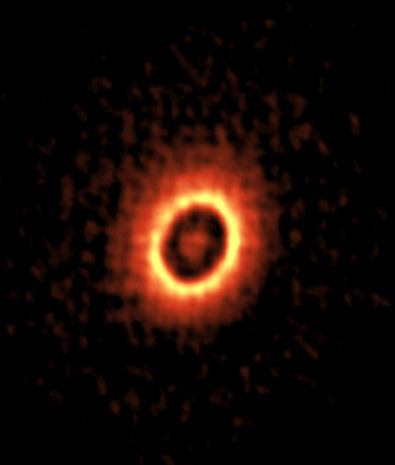
Image Credit: ALMA (ESO/NAOJ/NRAO), Kudo et al.
Within the heliospheric envelope of our own Sun's domain, interplanetary dust is generally removed by a combination of drag and expulsion by the solar wind. What little remains can sometimes be witnessed as 'zodiacal light'. This diffuse presence of dust within the Earth's local environment makes determining the scant presence of dust elsewhere very difficult. Beyond the heliosphere, some 120+ AU away (opinions differ as the the precise border), the forces generated by the Sun are absent, and replaced by a galactic tidal stream containing the interstellar medium. It is not cleared away as efficiently as interplanetary dust within the solar system.
This is something to ponder, because questions about Planet X and other worlds beyond the heliosphere may be informed by these different environmental conditions. In a nutshell - Planet X is technically located in interstellar space, even though it orbits around the Sun. That may have implications, particularly over the lifetime of the solar system. After all, the Sun itself travels through the galaxy, and the environment it finds itself in at any given time will vary accordingly. It may pass through gigantic molecular clouds, dusty lanes in spiral arms (4), even dense nebulae. At these times, the protective heliosphere enveloping the Sun's domain is pushed backwards (it's a dynamic border, dependent upon the pressure from both sides). Objects in the solar system may be subject to significant immersion in the cosmic dust at these times, and I contend that this creates opportunities for continued and substantial planetary accretion. When it comes to undiscovered planets beyond the heliosphere, this interstellar medium may also accumulate around them, tugged into their gravitational zones of influence, and further obscuring their already difficult luminosities (5).
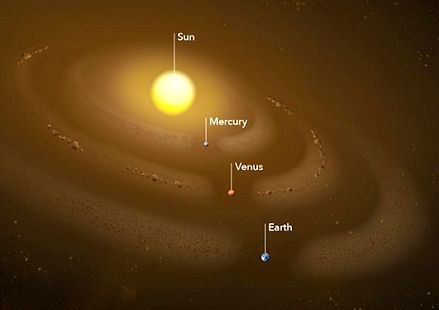
Image Credit: NASA's Goddard Space Flight Center/Mary Pat Hrybyk-Keith
Now, it seems, even the inner solar system, bombarded directly by the solar wind, may retain substantial rings of dust (6). There are two new dust rings to consider, in a part of the solar system which should be relatively dust-free. One runs along Venus's orbit, which may have been created by hypothetical asteroids co-orbiting Earth's sister world (7). Even more remarkable is a ring of dust enveloping the Sun's closest planet, Mercury. Incredibly, this inner ring of dust is over 9 million miles wide (8). Theoretically, it shouldn't be there: Its discovery was made during observations aimed at viewing an entirely dust-free region!
""People thought that Mercury, unlike Earth or Venus, is too small and too close to the Sun to capture a dust ring," Guillermo Stenborg of the Naval Research Laboratory, Washington, D.C. said. "They expected that the solar wind and magnetic forces from the Sun would blow any excess dust at Mercury's orbit away."" (6)
And yet, even in this zone, dust accumulates. The dust around Venus's orbit is even more significant:
"Because it's dispersed over a larger orbit, Venus' dust ring is much larger than the newly detected ring at Mercury's. About 16 million miles from top to bottom and 6 million miles wide, the ring is littered with dust whose largest grains are roughly the size of those in coarse sandpaper. It's about 10 percent denser with dust than surrounding space. Still, it's diffuse -- pack all the dust in the ring together, and all you'd get is an asteroid two miles across." (6)
The source of this dust is mysterious - it is too plentiful and too enduring to be sourced from the usual suspects in the solar system (in other words, the minor bodies we know about). Which has led scientists to model how the dust may have survived from the earliest period of the solar system's history aided and abetted by the presence of undetected asteroids co-orbiting Venus (7).
Instead, I wonder whether this dust penetrated the inner solar system from outside, particularly during periods when the Sun travelled through dense regions of the galaxy? Our solar system is not a closed, isolated environment, which the computer models tend to assume (or, at least, negate). Intermittent immersion in dense clouds of interstellar dust could provide the material scientists are seeking as the reason for these dust rings in the inner solar system.
So what of the outer solar system, where the boundaries with interstellar space lie? What might accumulated dust clouds do beyond the heliosphere, when tugged into position by a considerably larger Planet X body? Could such a body also be the shepherd for its own extensive train of dusty materials? For the last decade, it has been known that clouds of interstellar material lie beyond the heliosphere, which NASA have dubbed 'local fluff' (9). Given the sheer scope of the inner rings of dust cohabiting the orbits of the inner planets, a similar ring occupying the orbit of Planet X would surely be immense. After all, its orbit is that much greater, as well as its gravitational power. Most importantly, though, is that the mechanisms removing that dust in interstellar space are that much less, certainly compared to the inner solar system!
Written by Andy Lloyd,
16th March 2019
References
:1) Andy Lloyd “The Shroud Hypothesis” 12 January 2015
andylloyd.org/darkstarblog22.htm
2) Andy Lloyd “The Cumulative Effect of Intermittent Interstellar Medium Inundation Upon Objects In The Outer Solar System” Feb 2016, DOI: 10.13140/RG.2.1.5112.5526
3) ALMA "ALMA Observes the Formation Sites of Solar-System-like Planets" 14 March 2019,
4) Andy Lloyd “Down a Dusty Lane” 9th December 2016,
andylloyd.org/darkstarblog45.htm
5) Andy Lloyd "Darker Stars" Timeless Voyager Press, 2019
6) NASA/Goddard Space Flight Center "What scientists found after sifting through dust in the solar system" 12 March 2019
7) P. Pokorný and Marc Kuchner "Co-orbital Asteroids as the Source of Venus's Zodiacal Dust Ring". The Astrophysical Journal, 2019; 873 (2): L16
8) G. Stenborg, J. Stauffer, and R. Howard "Evidence for a Circumsolar Dust Ring Near Mercury's Orbit" The Astrophysical Journal, 868 (1)
9) Tony Phillips "Voyager Makes an Interstellar Discovery" 23 December 2009

You can keep informed of updates by following me on Twitter:
![]()
Or like my Facebook Page: https://www.facebook.com/darkstarandylloyd